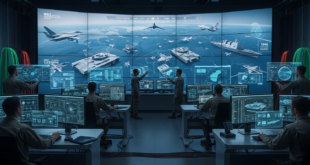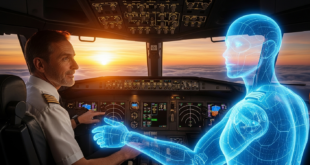Introduction:
In the realm of maritime security, submarines are the stealthy predators of the deep, challenging naval forces with their elusive nature. To counter this threat, militaries have long relied on sonar systems, the eyes and ears of ships and submarines, to detect and track underwater targets. However, with advancements in artificial intelligence (AI), the landscape of undersea warfare is undergoing a profound transformation. AI-powered technologies are revolutionizing submarine detection, offering unprecedented capabilities to enhance maritime security and surveillance.
The Submarine Challenge:
Submarines, often referred to as the “silent service,” are designed to operate covertly, evading detection by surface ships and aircraft. Their ability to remain hidden beneath the waves grants them a strategic advantage, enabling clandestine operations and posing a significant threat to maritime security. Traditional methods of submarine detection, such as sonar systems and magnetic anomaly detection, have limitations in effectively locating these stealthy adversaries, especially in complex underwater environments.
Advancements in Sonar Technology:
Sonar systems play a pivotal role in underwater surveillance, enabling naval forces to detect, locate, and identify objects beneath the waves. Traditionally, improvements in sonar performance have been driven by the evolving operational requirements of naval forces, particularly in littoral waters where the acoustic environment is challenging. Today, the emergence of near-silent submarines necessitates the development of modular acoustic systems with exceptional performance to ensure the effectiveness and safety of undersea missions.
AI: The Game-Changer in Submarine Detection:
The integration of AI into sonar systems marks a paradigm shift in undersea warfare. AI, encompassing machine learning (ML) and deep learning (DL) algorithms, empowers computers to perform tasks that traditionally require human intelligence, such as pattern recognition and decision-making.
Advanced AI algorithms, coupled with sensor fusion techniques, enable real-time analysis of vast amounts of data collected from various sources, including sonar arrays, unmanned underwater vehicles (UUVs), and satellites.
By leveraging ML and DL techniques, AI enables real-time analysis of vast amounts of sonar data, enhancing the accuracy and efficiency of submarine detection. Deep learning architectures, including deep neural networks and convolutional neural networks, have demonstrated remarkable capabilities in identifying underwater targets amidst complex acoustic environments.
One of the key advantages of AI-based submarine detection systems is their ability to distinguish between normal maritime traffic and potential submarine threats amidst the ocean’s noise. By leveraging machine learning algorithms, these systems can autonomously identify patterns indicative of submarine activity, thereby reducing false alarms and improving overall detection accuracy. Moreover, AI enables adaptive learning, allowing detection algorithms to continuously evolve and adapt to changing underwater conditions and tactics employed by hostile submarines.
Breakthroughs in AI-Powered Submarine Detection:
Researchers worldwide are pushing the boundaries of AI-driven submarine detection technologies. In a groundbreaking development, scientists from China and the United States have developed an AI-based system that revolutionizes submarine detection in uncharted waters. By leveraging deep-learning algorithms trained on virtual environments and real-life ocean data, the system can accurately locate underwater targets with unprecedented precision. This transformative technology promises to track sound-emitting sources, ranging from submarines to marine mammals, using simple listening devices mounted on buoys or underwater drones.
Commercialization of AI-Based Subsea Intelligence:
Beyond research laboratories, AI-based technologies are making waves in the commercial subsea sector. Coda Octopus Group, a global leader in 3D sonar technology, has unveiled its Automatic Object Detection (AOD) software series, leveraging AI to automate the identification of subsea objects. By harnessing AI algorithms, the AOD software streamlines the detection and classification of distinct underwater features, ranging from boulders to mine-like objects (MLOs). This breakthrough technology promises significant cost savings and productivity gains for subsea operators in both commercial and defense applications.
Enhancing Submarine Vulnerability:
As militaries deploy AI-driven submarine detection systems, the balance of power in undersea warfare is shifting. Submarines, once considered invulnerable, are now facing increased exposure and vulnerability to detection. AI algorithms excel in analyzing complex underwater acoustics and identifying subtle anomalies that betray the presence of a submerged vessel. Additionally, AI-enabled sensor networks enhance situational awareness, enabling naval forces to track and neutralize submarine threats more effectively.
Challenges
However, the adoption of AI in submarine detection also presents challenges and ethical considerations. Concerns regarding the reliability and robustness of AI algorithms, as well as the potential for false positives or adversarial attacks, must be addressed. Moreover, the proliferation of AI-driven detection technologies raises questions about transparency, accountability, and the potential for unintended escalation in maritime conflicts.
Looking Ahead:
As AI continues to evolve, the future of submarine detection holds limitless possibilities. With ongoing advancements in AI algorithms and sensor technologies, naval forces can expect unprecedented capabilities in undersea surveillance and reconnaissance. However, as AI becomes increasingly integral to maritime security operations, ethical considerations and international cooperation will be paramount to ensure responsible and transparent use of AI-driven technologies. Future advancements may include the integration of AI with emerging technologies such as quantum sensors, underwater drones, and autonomous underwater vehicles (AUVs), further enhancing the ability to detect and counter submarine threats.
As we embark on this transformative journey, collaboration between researchers, industry stakeholders, and policymakers will be essential to navigate the complex challenges and opportunities presented by AI in undersea warfare. Additionally, international cooperation and dialogue will be essential to establish norms and regulations governing the responsible use of AI in maritime security operations.
Conclusion:
The convergence of AI and sonar technology heralds a new era in undersea warfare, where submarines are no longer hidden threats but detectable adversaries. With AI as their ally, naval forces possess the tools to maintain maritime security and protect critical oceanic interests. While AI-driven detection systems hold tremendous promise for enhancing maritime security, they also raise important ethical and strategic considerations that warrant careful attention
As we embrace the potential of AI in submarine detection, we embark on a journey towards a safer, more secure underwater domain, where the silent hunters of the deep are no match for the power of human ingenuity and technological innovation.
For military, Sonars are the eyes and ears of ships or submarines in water used to detect, locate and identify objects in water. They are used for underwater navigation, especially by submarines and surveillance. Sonar systems can also be used to realign inertial navigation systems by identifying known ocean floor features.
Improvements in sonar performance are driven by the increasing need for naval forces to operate in the harsh acoustic environment of littoral waters, and by the emergence of new generations of near-silent submarines. This shift in operating conditions calls for modular acoustic systems with very high levels of performance in order to provide submarines with the capabilities they need to perform their missions effectively and safely.
Yet another sonar improvement being investigated would apply to shallow waters that are often noisy. By studying those waters at different times of year and understanding how sound ricochets through them, improvements can be made in how an actual signal of a specific vessel might be better separated from the noise.
Now militaries are employing Artificial Intelligence to improve the performance of Sonars. The general definition of AI is the capability of a computer system to perform tasks that normally require human intelligence, such as visual perception, speech recognition and decision-making. Machine Learning (ML) is a subfield of Artificial Intelligence which attempts to endow computers with the capacity of learning from data, so that explicit programming is not necessary to perform a task. One of the most successful machine learning algorithms is deep learning (DL) that allow high-level abstraction from the data, and this is helpful for automatic features extraction and for pattern analysis/classification.
Various deep learning architectures such as deep neural networks, convolutional deep neural networks, and deep belief networks have been applied to fields like computer vision, automatic speech recognition, natural language processing, and music/audio signal recognition where they have been shown to produce state-of-the-art results on various tasks.
Scientists from China and the United States have developed a new artificial intelligence-based system that they say will make it easier to detect submarines in uncharted waters. The technology builds on earlier work by the team, led by Dr Niu Haiqiang from the Institute of Acoustics at the Chinese Academy of Sciences in Beijing, which saw them develop a deep-learning algorithm that could improve the speed and precision of detection. The algorithm, however, needs a large amount of data to work, so its use is limited to waters that have already been fully charted. In contrast, the upgrade works in all waters, charted or otherwise.
Some experts have speculated that Submarines might be obsolete by the middle of the century. It’s possible that advances in artificial intelligence (AI), detection systems and signal processing, combined with swarming autonomous unmanned systems, could make it effectively impossible for submarines to maintain their stealth.
Chinese, scientists employ AI technology to help detect submarines in uncharted waters
Niu and his colleagues, who included scientists from the Scripps Institution of Oceanography at the University of California San Diego, started by developing a simulator to generate a wide range of virtual environments from which the algorithm was able to learn. Once it had assimilated that information, the simulator was able to analyse real-life data taken from the world’s oceans and seas, the team said in a paper published in the July issue of The Journal of the Acoustical Society of America.
It is now able to help a single hydrophone locate more than 80 per cent of underwater targets within an uncharted area with a margin of error of less than 10 metres (33 feet), the paper said.
The researchers said the new technology should allow them to track any sound-emitting source – be it a nuclear submarine, a whale or even an emergency beeper from a crashed aircraft – using a simple listening device mounted on a buoy, underwater drone or ship. The scientists worked together to improve the sensitivity and accuracy of passive underwater surveillance technology, according to the academy’s website.
Professor Zhang Renhe, a researcher at the Institute of Acoustics who was not involved in the study, said the latest development was encouraging. “AI can be a useful assistant to underwater target recognition,” he said. “In a way it is similar to the speech recognition technology on our mobile phones.”
But he said scientists were still wrestling with exactly how the technology worked. “It is like a black box with some inner workings that are still unexplained,” he said. Researchers were now working on ways to combine the new AI technology with the physical models for underwater target detection that have been developed in recent decades, Zhang said. “This is a new frontier for fundamental science,” he said. “It requires international cooperation.”
Coda Octopus Launches Artificial Intelligence-Based Product for Automatic Object Detection and Identification
Coda Octopus Group, , a global leader in real-time 3D sonar technology and real-time subsea intelligence, announced the launch of its newest breakthrough technology, an artificial intelligence-based Automatic Object Detection (AOD) software product series which presents an opportunity to extend its customer base. CODA’s AOD allows users to automatically detect and recognize distinct subsea objects, such as boulders or mine-like objects (MLOs). The technology provides significant cost savings and reduces the time required for subsea operations both within the commercial and defense space.
CODA’s initial product in its AOD series is the Survey Engine Automatic Object Detection Package (SEADP), based on algorithms designed and developed around Artificial Intelligence (AI) techniques. The SEADP enables geophysicists to automatically accomplish a previously manual, painstaking and costly task. After geophysical users collect data at sea, they then spend many labor hours going through this data manually to identify, tag and report on boulders within the seabed site.
“Our SEADP has been in trial with two significant customers who have reported significant productivity gains by using the SEADP. In one such trial, the SEADP package accurately recorded 4,600 boulder contacts in 3km of line data within nine minutes, and produced the contact report detailing the ping number, boulder position, and boulder size within 50 minutes. This level of data would typically have taken about three days, including preparing reports,” continued Ms. Gayle.
CODA’s SEADP AI technology development continues with a current focus on man-made objects (MMOs) and mine-like objects (MLOs) detection and classification. These AOD products will form part of CODA’s future technology releases for MLO detection for defense/military customers.
Annmarie Gayle, CODA’s Chairman and CEO, commented: “The subsea market is evolving and seeking technology that can increase productivity gains, thus reducing costs of its operations. This is exactly what our new artificial intelligence-based technology allows our customers to achieve. We are very excited to have accomplished this breakthrough AI technology, which based on early customer trials is set to revolutionize the workflow process for many subsea operators.
 International Defense Security & Technology Your trusted Source for News, Research and Analysis
International Defense Security & Technology Your trusted Source for News, Research and Analysis


